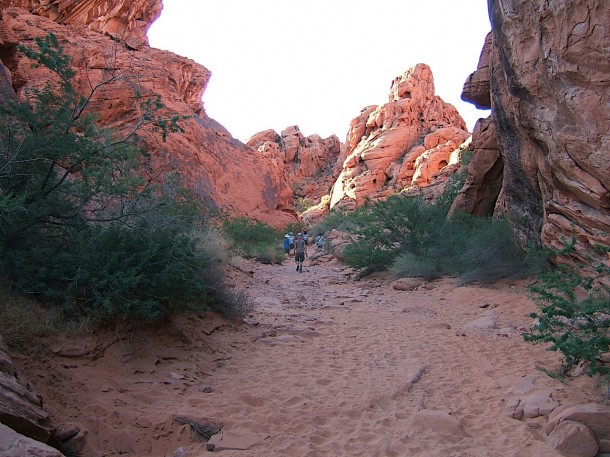One of the most beautiful features of the desert are the brillant red rocks that are scattered throughout southern Nevada. These vivid hues can be best observed in the appropriately named, Valley of Fire.
Looking across the barren, hot, desert valley it is hard to believe that 600 milion years ago the entire area was under water. Animal and plant life was abundant here at that time and as the waters subsided over the next 400 million years the thriving ocean floor became a unique desert valley. The sandstone rocks vary in color from deep reds and purples to tans and whites and their unique formations have been formed by millions of years of erosion, wind and climatic change.
Some of the most interesting rock formations are the “Seven Sisters” which are seven unusal rock formations which stand in a row. They are remnants from the harsh erosion which has changed their shape over the years.
Ancient and Modern Man in the Valley of Fire
To look at this harsh desert landscape it is difficult to believe that ancient people once thrived here. Evidence of their lifestyle has been left behind in petroglyphic drawings. A few archaelogists believe that people lived here as long ago as 15,000 years although that assumption has been unproven most would agree that man was present here about 4,000 years ago. Small enclaves of families roamed and hunted in this area. Their main diet consisted of bighorn sheep and smaller game such as rabbits and tortoises. The first record of Europeans in the area was when the famous mountain man Jedediah Smith, who led the first party of fur trappers into the area in 1826. He was followed by Kit Carson in the 1840s. Just like a tale from an old western movie the Europeans and the Paiute people who had inhabited this area fought over the ownership of the land and its animals.
Mouse’s Tank
One of the greatest legends of the Valley of Fire is about a Paiute Indian named Mouse. Mouse was a known outlaw who worked on ferry that crossed the Colorado River. After a drunken episode where he shot up an Indian camp his employers fired him and dumped him off in Arizona. There, it is said, he killed two prospectors. A intensive search was conducted but Mouse could not be found. Apparently during these episodes Mouse would flee to the Valley of Fire to hide out. Here he would sometimes use “Mouse’s Tank”, a depression in the rocks that catches and holds rainwater for a time after storms. Mouse’s Tank is well hidden within the maze of rock formations on the Petroglyph Canyon floor, a perfect hideout for a fugitive. On July 11, 1897 a posse tracked Mouse near Muddy Spring and ordered him to surrender. Mouse would not give up and after a gun fight with the law Mouse was shot and killed.
On the trail to Mouse’s Tank
Valley of Fire located 55 miles from Las Vegas it spans more than 37,000 acres. Nevada’s first state park, composed of stunning red sandstone formations and a wealth of Indian artifacts and petroglyphs. A vistors’ center provides information on the park’s history and geology. The Lost City Museum is located nearby. Valley of Fire Vistor Center: (702) 397-2088.
Tags: Hiking, indian, Lake Mead, Mouse's Tank, Nevada State Park, Overton, Paiute, petroglyphic, sandstone, Seven Sisters, Valley of Fire

